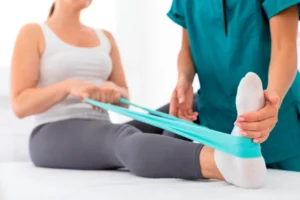Sciatica is the name given to any sort of pain caused by irritation or compression of the sciatic nerve. The pain can range from being mild to very painful, and may be made worse by sneezing, coughing or sitting for a long period of time. While people with sciatica can have general back pain other symptoms can be
- Pain in the rear of leg that is worse when sitting.
- Hip pain.
- Burning or tingling down the leg.
- Weakness, numbness, or difficulty moving the leg or foot.
- A constant pain on one side of the back of leg.
- A shooting pain that makes it difficult to stand.
Common Causes Of Sciatica
- Spinal stenosis – narrowing of the nerve passages in the spine.
- Spondylolisthesis – when a vertebra slips out of position.
- A spinal injury or infection.
- A growth within the spine – such as a tumor.
- Cauda equina syndrome – a rare but serious condition caused by compressed and damaged nerves in the spinal cord.
Pseudo Sciatica
Though heard a lot of times in day to day life, Sciatica actually is not that common. There are many non-discogenic causes of sciatica. And more than often Sciatica is miss-used in place of pseudo-sciatica which can cause many misunderstandings for the patients. Pseudo sciatica is a rather common condition. Basically pseudo-sciatica is the term that is used to describe the condition that arises when the peripheral regions of the sciatic nerve is compressed. The compression is usually caused by tension that has been created within the gluteal muscles, which are the very large muscles that actually form the buttock area and they assist the thighs in moving efficiently. The piriformis muscle or even the psoas muscles may also cause tension to be created. Often a mal aligned/off-axis hip joint can compress on the nerve and muscles. While few symptoms of pseudo-sciatica are same as sciatica but in pseudo sciatica radiating pain area is limited to back of thigh and knee region or sometimes till calf muscle. Also there is less chances of muscle weakness of lower limbs.
Pseudo sciatica is often caused by poor posture or even by too much exercise. Sitting for long period of time at a computer can also cause compression. The other main causes relate to sitting or even standing in the same position for too long. Men who sit for very long periods (especially on a hard seat) with their wallet in the back pocket of their trousers can also develop pseudo-sciatica. It is, as a result, quite common, although it is sometimes simply called sciatica and not pseudo-sciatica. Basically, pseudo-sciatica is the term that is used to describe the condition that arises when the peripheral regions of the sciatic nerve is compressed. The compression is usually caused by tension that has been created within the gluteal muscles, which are the very large muscles that actually form the buttock area and they assist the thighs in moving efficiently. The piriformis muscle or even the psoas muscles may also cause tension to be created. Often a mal aligned/off-axis hip joint can compress on the nerve and muscles. While few symptoms of pseudo-sciatica are same as sciatica but in pseudo sciatica radiating pain area is limited to back of thigh and knee region or sometimes till calf muscle. Also there is less chances of muscle weakness of lower limbs.
Pseudo sciatica is often caused by poor posture or even by too much exercise. Sitting for long period of time at a computer can also cause compression. The other main causes relate to sitting or even standing in the same position for too long. Men who sit for very long periods (especially on a hard seat) with their wallet in the back pocket of their trousers can also develop pseudo-sciatica. It is, as a result, quite common, although it is sometimes simply called sciatica and not pseudo-sciatica.
How FMT TM Works?
VARDĀN uses Functional Manual TherapyTM , a unique and holistic manual therapy approach, not only helps you in properly assessing & diagnosing the root cause of pseudo-sciatica and thereby treating the biomechanical factors causing this pain, but also gives you tailored exercises and effective postural advice in rehabilitating you thoroughly and keeping this pain at bay, so that you can return to your desired activities pain-free.




